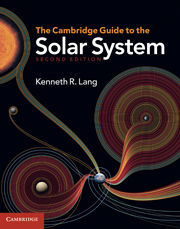Book contents
- Frontmatter
- Contents
- List of focus elements
- List of tables
- Preface to the second edition
- Preface to the first edition
- Principal units
- Part 1 Changing views and fundamental concepts
- Part 2 The inner solar system: rocky worlds
- Part 3 The giant planets, their satellites and their rings: worlds of liquid, ice and gas
- 9 Jupiter: a giant primitive planet
- 10 Saturn: lord of the rings
- 11 Uranus and Neptune
- Part 4 Remnants of creation: small worlds in the solar system
- Part 5 Origin of the solar system and extrasolar planets
- Author index
- Subject index
11 - Uranus and Neptune
from Part 3 - The giant planets, their satellites and their rings: worlds of liquid, ice and gas
Published online by Cambridge University Press: 05 August 2011
- Frontmatter
- Contents
- List of focus elements
- List of tables
- Preface to the second edition
- Preface to the first edition
- Principal units
- Part 1 Changing views and fundamental concepts
- Part 2 The inner solar system: rocky worlds
- Part 3 The giant planets, their satellites and their rings: worlds of liquid, ice and gas
- 9 Jupiter: a giant primitive planet
- 10 Saturn: lord of the rings
- 11 Uranus and Neptune
- Part 4 Remnants of creation: small worlds in the solar system
- Part 5 Origin of the solar system and extrasolar planets
- Author index
- Subject index
Summary
• Uranus and Neptune were unknown to ancient astronomers, and were not discovered until after the invention of the telescope.
• Uranus is just barely visible to the unaided eye, and Neptune requires a telescope to be seen.
• The blue-green, turquoise color of Uranus and the indigo blue color of Neptune come from methane in their clouds.
• Uranus and Neptune have a similar size, mass, and bulk composition, and they are both much smaller, less massive, and denser than the other two giant planets, Jupiter and Saturn.
• In contrast to all the other planets in the solar system, Uranus is tipped sideways so its rotation axis lies nearly within the planet's orbital plane, leading to extreme seasonal variations in solar heating of the planet's polar regions.
• Although Uranus apparently has no strong internal source of heat, Neptune radiates 2.7 times the energy it absorbs from the Sun. The source of Neptune's excess energy is most likely heat left over from the planet's formation.
• The cloud bands and winds on Uranus blow parallel to the planet's equator, apparently controlled by the planet's rapid spin rather than by direct heating from the Sun.
• Despite receiving a relatively small amount of sunlight compared to the other major planets, Neptune's atmosphere is surprisingly active and dynamic, with large storm systems and high-speed winds that may be driven by internal heat. […]
- Type
- Chapter
- Information
- The Cambridge Guide to the Solar System , pp. 348 - 364Publisher: Cambridge University PressPrint publication year: 2011



